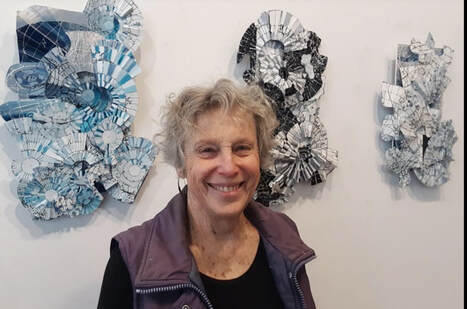Phyllis Ewen - Artist

Phyllis Ewen 's studio is in the Brickbottom Artist Building, Somerville, MA, where she was a founding member. Her work has been exhibited extensively and is in many public collections, including the Boston Museum of Fine Arts, The Boston Public Library, Harvard and MIT, the Decordova Museum and Sculpture Park, and in numerous corporate and private collections.
Ewen is represented by the Kingston Gallery in Boston, AMP Gallery in Provincetown MA and AiR Gallery in Brooklyn NY.
Phyllis Ewen’s 3-dimensional reliefs invite us to imagine ourselves within the seascape above and below the surface of the water. In the topographical waterscapes such as Northern Waters 8 and Drift I has scanned charts and weatmy maps, altered them in Photoshop, and printed them digitally. These pigment prints are then cut and reassembled to form imagined waterscapes that highlight the changing nature of our seas; rising waters and melting glaciers – the effects of global warming and human intervention. I add paint, graphite and puzzle pieces. Although maps imply a viewer looking down at the landscape, Phyllis hopes” that the dimensional qualities of my images allow us imagine ourselves within it; that to inhabit the seas as another way of understanding.”
Melting glaciers and warming seas have affected the sea floor itself. In The Deep imagery is drawn from maps of the ocean floor plotted in the 1950s and 1960s by geologist Marie Tharp.
In these pieces we find ourselves under the surface of the sea we wander among the mountains, valleys, and canyons of the ocean floor. The depth and texture in these works are both illusion and actual. Layers are attached with magnets, reflecting the magnetic energy of the earth’s tectonic plates. My palette has darkened as has the mood reflecting the ecological dangers we face.
Ewen is represented by the Kingston Gallery in Boston, AMP Gallery in Provincetown MA and AiR Gallery in Brooklyn NY.
Phyllis Ewen’s 3-dimensional reliefs invite us to imagine ourselves within the seascape above and below the surface of the water. In the topographical waterscapes such as Northern Waters 8 and Drift I has scanned charts and weatmy maps, altered them in Photoshop, and printed them digitally. These pigment prints are then cut and reassembled to form imagined waterscapes that highlight the changing nature of our seas; rising waters and melting glaciers – the effects of global warming and human intervention. I add paint, graphite and puzzle pieces. Although maps imply a viewer looking down at the landscape, Phyllis hopes” that the dimensional qualities of my images allow us imagine ourselves within it; that to inhabit the seas as another way of understanding.”
Melting glaciers and warming seas have affected the sea floor itself. In The Deep imagery is drawn from maps of the ocean floor plotted in the 1950s and 1960s by geologist Marie Tharp.
In these pieces we find ourselves under the surface of the sea we wander among the mountains, valleys, and canyons of the ocean floor. The depth and texture in these works are both illusion and actual. Layers are attached with magnets, reflecting the magnetic energy of the earth’s tectonic plates. My palette has darkened as has the mood reflecting the ecological dangers we face.